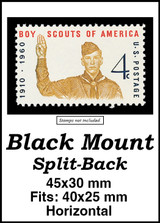U.S. #1272
5¢ Traffic Safety
Issue Date: September 3, 1965
City: Baltimore, MD
Quantity: 114,085,000
Printed By: Bureau of Engraving and Printing
Printing Method: Giori press
Perforations: 11
Color: Emerald, black and red
Publicizes the impor... more
U.S. #1272
5¢ Traffic Safety
Issue Date: September 3, 1965
City: Baltimore, MD
Quantity: 114,085,000
Printed By: Bureau of Engraving and Printing
Printing Method: Giori press
Perforations: 11
Color: Emerald, black and red
Publicizes the importance of traffic safety, the prevention of traffic accidents, and the necessity of lowering the highway death rate.
First Electric Traffic Light
On August 5, 1914, the first electric traffic light was installed in Cleveland, Ohio.
London was home to some of the first non-electric gas-lit traffic lights. They were installed in December 1868 outside the Houses of Parliament. The lights were created because an overflow of horse-drawn traffic forced large numbers of pedestrians to walk in front of the Houses of Parliament.
These early lights were called semaphores and they used gas lanterns operated by a policeman. The officer would manually turn the device with a lever so the correct light would face each side of traffic. While the device was successful, a gas leak led to an explosion that hurt a policeman and the light’s use was discontinued.
By the early 1900s, similar semaphore traffic signals were in use around America, though each state adopted its own design. In the early part of the 20th century, innovations to traffic control came quickly. In 1912, Salt Lake City police officer Lester Wire built a wooden box with red and green lights that he mounted on a pole. It had wires attached to overhead trolley and light wires. Garrett Morgan also invented a traffic signal with a T-shaped design that was later patented in 1923.
But Cleveland, Ohio, is largely credited as the home of the first electric traffic signal. The light was designed by James Hoge and installed at the corner of 105th Street and Euclid Avenue on August 5, 1914. Hoge’s design used four pairs of red and green lights mounted on a corner post. They were wired to a manually operated switch in a control booth using a system that prevented the possibility of conflicting signals. The lights had words “stop” and “move” in them and a buzzer to warn of impending color changes. Hoge’s system also permitted police and fire stations to chance the signals when there was an emergency.
Concerning Hoge’s light, a contemporary article proclaimed, “This system is, perhaps, destined to revolutionize the handling of traffic in congested city streets and should be seriously considered by traffic committees for general adoption.”
Three years later, Salt Lake City installed a system that connected lights at six intersections that were controlled by the same manual switch. Another major milestone occurred in 1920 in Detroit, Michigan. There, Police Officer William L. Potts wanted to make the streets safer. Inspired by the system of railroad signals, he connected red, amber, and green lights with $37 worth of wire and electrical controls to make the world’s first four-way three-color traffic light. In less than a year, 15 of these lights had been put in place in Detroit alone.
In 1922, the use of police officers in traffic control began to decline as traffic towers were adopting automatic timers. This was further improved in the 1950s with the introduction of computers to control the lights. In some areas, a pressure plate was placed in the ground to detect the arrival of a car at a red light, which would signal the need to change the light.
Today, nearly every country in the world uses electric traffic lights with the exception of Bhutan, which still utilizes police to direct traffic.
Less 









